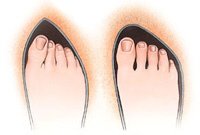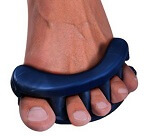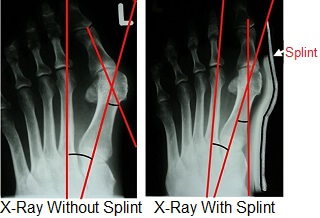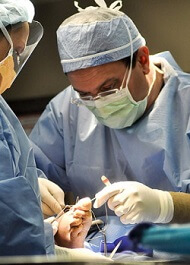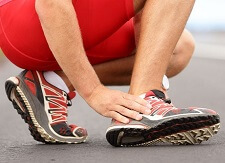- Home
- Common Foot Problems
- Bunions
- Treatment
Bunions Treatment
Written By: Chloe Wilson BSc(Hons) Physiotherapy
Reviewed By: FPE Medical Review Board
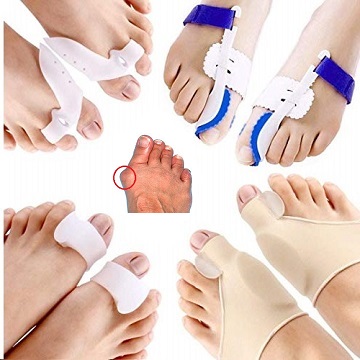
Bunions treatment aims to reduce the pain, deformity and daily impact of bunions as well as preventing progression of the condition.
Foot bunions develop when the toe changes position, gradually pushing inwards which creates a hard, painful lump on the side of the foot.
Most often it is the big toe that is affected, known as hallux valgus, but in some cases they develop on the little toe, known as bunionettes.
Bunions treatment aims to reduce the symptoms associated with bunions such as pain and swelling, as well as preventing the progression of the deformity. Whilst there is no specific cure for bunions there are a number of things that can really help.
Here, we will start by looking at a whole range of non-surgical bunions treatment. We will then go on to look at the surgical options. If you want to know more about bunions and how they develop, visit the bunions overview.
Non-Surgical Bunions Treatment
Most of the time, non-surgical (conservative) foot bunions treatment can control the symptoms. Bunions treatment typically includes:
1. Appropriate Footwear
One of the most common causes of hallux valgus are wearing tight, narrow shoes or high heels. These tend to squash the toes and push them inwards causing bunions to develop.
One of the simplest bunions treatments is to switch to flat, wide fitting shoes. This reduces the pressure on the area which not only helps relieve symptoms, it can also help slow or even halt the progression.
Whilst it might sound too good to be to true, studies have shown a real correlation between shoe wearing and the condition. In non-western countries where people either go barefoot, or wear unrestrictive footwear, the prevalence of bunions is approximately 3% of the general population. In western countries, the figure is ten times that with approximately 30% of the population affected.
2. Toe Stretchers
Toe stretchers are also good bunions treatments. They fit in-between the toes, helping to spread them apart and to stretch the muscles and ligaments around the toes. This helps to improve the alignment and flexibility of the toes and to relieve pain. Toe stretchers are designed to be used when you are sitting down or sleeping, rather than for when you are up and about.
There are a whole range of toe stretchers out there from gel ones to comfy stretcher socks. You can find out more about how these work and read user reviews in the Toe Stretcher section.
3. Medication
You doctor may prescribe or recommend over-the-counter medication to reduce the pain and inflammation as part of your bunions treatment. Whilst medication isn't a cure for hallux valgus, it can help reduce the symptoms to allow you to get on with your normal activities.
4. Toe Splint Orthotics
There are a number of over-the-counter shoe orthotics that can help relieve the symptoms of bunions.
Bunion splint correctors work by realigning the bones in your foot, straightening out the toe, as shown in this x-ray. This helps to reduce pressure on the affected toes and relieve pain.
There are various different types of corrector splints on the market including ones for daytime use and others for night-time wear - find out loads more in the bunion splint section.
5. Ice Treatment
Ice is another simple yet effective bunions treatment. Applying ice packs to the foot helps to reduce bunion pain and inflammation and can really help after you have been on your feet for long periods.
Visit the ice treatment section to find out how to safely and effectively use ice to gain the most benefit for your bunion pain and how to make sure you don't actually make things worse.
6. Bunion Pads
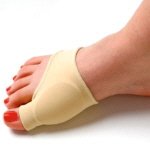
Another useful bunions treatment is cushioned bunion pads. You can also get protective foot cushions that sit over the skin to prevent the hallux abducto valgus rubbing on your shoes. Whilst they don't really change the position of the toes, they do prevent friction over the area of the bunion, making them particularly useful in the early stages before the toe has deviated too far.
In the bunion pad section we'll help you find the best bunions treatment pad for you.
Surgical Bunions Treatment
Conservative bunions treatments help to reduce the symptoms but they cannot undo changes in the bone to fully correct the condition. If bunion pain becomes severe and it starts to affect your daily life, then an operation may be the best option to correct a hallux abducto valgus.
There are a number of different surgical options, depending on the severity of the bony deformity. The two most common types of bunion surgery performed are:
1. Osteotomy
An osteotomy is the most common type of bunion surgery and involves removing part of the bony lump and realigning the toes. It is also known as a bunionectomy or exostectomy. The ligaments around the big toe may also need realigning and this will be done at the same time if necessary.
2. Fusion
Fusion surgery is where the joint at the base of the big toe (metatarsophalangeal joint) is fused together, known as an arthrodesis. This is only indicated in severe cases or if other bunions treatments have failed as it severely limits the movement of the big toe.
Bunion surgery takes place either under local or general anaesthetic and takes about one hour. You can find out more about the different types of surgery in the bunion operation section.
Recovering From Bunion Surgery
After bunion surgery you will have either a plaster cast or special dressing on the foot. You will be given a special walking shoe and crutches to use the first few days/weeks.
Recovery from bunion surgery usually takes approximately 6-8 weeks but swelling often lasts longer and it may take a few months before you are able to wear normal shoes again. Full recovery can take up to a year.
You can find out loads more, including our top tips in the bunion surgery recovery section.
Bunion operations are successful in approximately 85% of cases, but it is vital not to go back to wearing ill-fitting shoes else the problem is likely to return.
What Else Can Help?
You can find out more about each of these bunions treatments by using the link above. If you want to know more about bunions, choose from the following sections:
- Bunion Guide: An overview of the condition including common causes
- Symptoms: Includes both classic and less common symptoms
- Surgery: Different surgical options available
- Recovering from Surgery: Recovery guide for after surgery
- Top Products: Things that can help with prevention or recovery from surgery
A hallux valgus is just one cause of toe pain. If bunions aren't sounding quite like your problem, visit the toe pain diagnosis section for help working out what might be causing your pain.
Page Last Updated: 01/22/24
Next Review Due: 01/22/26
